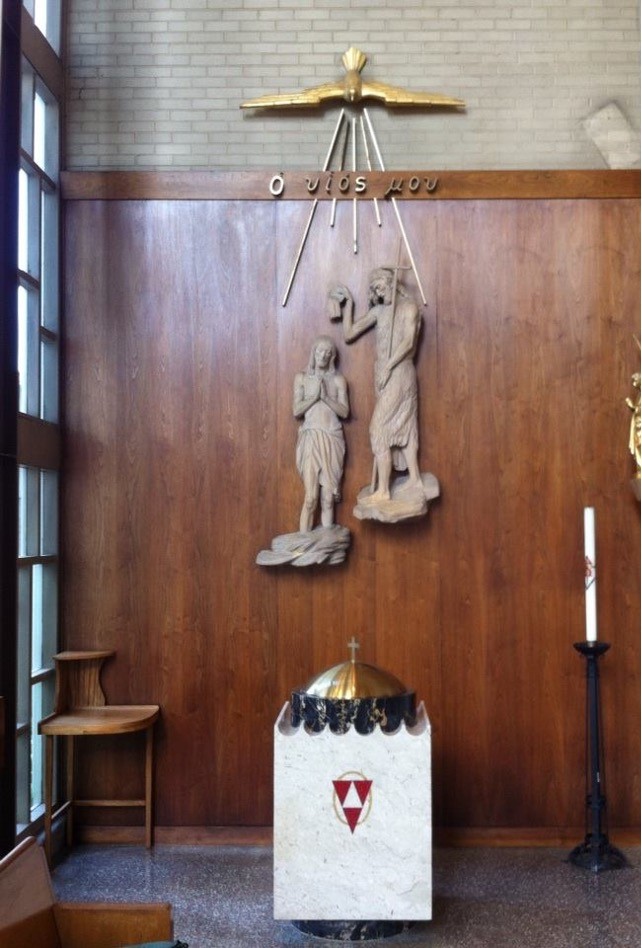Leopoldo A. Sánchez is professor of Hispanic ministries and systematic theology at Concordia Seminary in St. Louis, Missouri. His many academic interests include pneumatology (Holy Spirit), Spirit Christology, and Global South Christianity. He also plays double bass in the St. Louis Civic Orchestra. Sánchez’s most recent books are T & T Clark Introduction to Spirit Christology (2021) and Sculptor Spirit: Models of Sanctification from Spirit Christology (2019). In this edited conversation, he discusses worship practices that attune Christians to the Holy Spirit’s work not only in Advent and Christmas but through the whole church year.
Why do you recommend worship practices that reveal the Holy Spirit’s work in the life of Christ?
I’ll explain this by using two terms from my Sculptor Spirit book. I write that Logos Christology and Spirit Christology are two complementary ways of speaking about the one Jesus. These are not two different Christs. This is one Christ seen from two different angles. Logos comes from the Greek word for “word,” as we see in John 1:1 and John 1:14. The Son is presented to us as God-with-the-Father, the One who has taken on himself human flesh. Logos Christology emphasizes that Jesus is truly God and truly man. Its primary confession, that Jesus is the incarnate Word, begotten of the Father, was affirmed by the Council of Nicea in 325. They wanted to affirm Christ's divinity over groups that denied it.
Spirit Christology adds on to Logos Christology. As we also see in John 1, John the Baptist testifies that he saw the Spirit come down on Jesus (v. 32–33). John bears witness, saying, “The man on whom you see the Spirit come down and remain is the one who will baptize with the Holy Spirit.” So, Jesus Christ is the receiver, bearer, and giver of the Spirit. This distinguishes him from prophets in the days of old, when the Spirit descended on specific prophets for specific messages. But in Jesus, the Spirit remains, because he is the fulfillment of the prophets. And through him, the same Spirit remains on us, his disciples.
How can Spirit Christology make a difference for worshipers?
Many Christian traditions use a three-year lectionary of prescribed weekly Sunday scripture readings that center on the birth, ministry, death, and resurrection of Jesus Christ. When the Revised Common Lectionary (RCL) says something about the Spirit in Christ’s life, pastors usually emphasize what the life of Christ looks like. When I did a Calvin Symposium on Worship session on Holy Week, I observed that there’s a piety in wanting to look at the life of Christ.
Thus, pastors may feel reluctant to talk about us instead of Jesus. But then they miss out on showing how the text asks us to walk with Jesus and participate in his life. It’s OK to read a text in a Logos Christology way, focusing on Christ’s divine acts. But it’s also good to read a text from a Spirit Christology lens, focusing on how Christ bears and gives the Spirit to us. This lens helps preachers ask, “What is the Holy Spirit inviting us into in this passage about Christ?” This lens reminds us that we don’t have to try so hard on our own to be like him. Instead, we can remember that Jesus, the bearer of the Spirit, generously gives us the Spirit. The Spirit, working in and through us, has many ways to gently shape and work with us to be more Christlike.
How does the lectionary reveal the Holy Spirit at work during Advent and Christmas?
Advent/Christmas passages prepare us for the great works of the Spirit in the conception of Jesus, sanctification of Mary, John the Baptist preparing the way of the Lord, and more. Explicit and implicit examples include Matthew 3:1–12 in Year A Advent 2, Matthew 1:18–25 and Romans 1:1–7 in Year A Advent 4, Hebrews 2:10–18 in Year A First Sunday after Christmas,Luke 1:46b–55 in Year B Advent 3 and Year C Advent 4, Luke 2:22–40 in Year B First Sunday after Christmas, portions of John 1 in every Christmas Day and every Second Sunday after Christmas or Epiphany, and many more.
These texts prepare us to ask the Holy Spirit to open our hearts and receive what Jesus brings us: an invitation into a life of faith, service, sacrificial giving, and hospitality. In Christ and in us, the Holy Spirit engenders life in holiness and love for God and neighbors.
How else can worship planners focus worshipers’ attention on the Holy Spirit’s work at Christmas—and beyond?
I recommend consulting the Vanderbilt University’s RCL website because it has resources such as prayers and artwork for all lectionary readings. Also, look around your church’s sanctuary, closet, or basement. See if there are banners, artwork, stained glass windows, a baptismal font, or something else already in place that could be used as a pedagogical tool for highlighting the Spirit’s role in Advent/Christmas or another liturgical season.
Can you share some personal examples of using existing art to point out the Spirit’s presence?

In my congregation, when you look up front in the sanctuary, you see the baptismal font to the left of the altar. A dove hangs from a string above the font. You can’t see the string, and I don’t know who put the dove there or when. But it visually illustrates the Holy Spirit descending. When I preach there, I often remind worshipers, “The Spirit who hovers over the waters of Genesis is the same who overshadows Mary, hovers over Jesus’ baptism, and hovers over the font where you were baptized. This means that, through the Spirit, whom Christ sends to us, we are invited to participate in the life of the Trinity.”
When I wrote my Sculptor Spirit book, I put a photo next to my computer of the font at St. Paul’s Lutheran Church in Melrose Park, Illinois. I preached a baptism sermon there. Their baptismal font is in a front corner of the sanctuary. Above the font is a relief sculpture with a golden metal dove. Below that, gold letters in Greek say, “You are my son.” And under that you see John the Baptist standing above Jesus to baptize him. The baptismal font itself has a trinitarian symbol. This positioning emphasizes that Jesus did not come to be served but to serve and to give his life as a ransom for many. I preached from that font to illustrate that the baptized child, like Jesus, was anointed with the Spirit to enter a life of sacrifice and service for others.
How might you tweak a Mexican Las Posadas event to emphasize the Holy Spirit at Christmas?
In a traditional Las Posadas, the Holy Family is looking for a posada (inn) for the child. Pilgrims accompany the Holy Family, knocking on doors. They sing, “In the name of heaven, I beg you for lodging, because she cannot walk.” In the same melody, the unwelcoming person or innkeeper behind the door sings, “This is not an inn. Keep going. I can’t open my door because you may harm me.” They keep going, only to be rejected at other inns until finally the last innkeeper welcomes the child Jesus with song: “Enter holy pilgrims, receive this humble space.” It is a story of rejection, faith, and hospitality.
I imagine that you could liturgically adapt Las Posadas to bring out the Spirit’s role in turning innkeepers from rejecting Jesus to welcoming him in by faith. The Spirit opens our eyes to see God’s salvation in Jesus. The Spirit also leads us to repentance for rejecting strangers (pilgrims) who, like the Holy Family, seek welcome in our homes and hearts, in our churches and communities.
We can ask the Spirit to help us recognize which marginalized members in our church, family, community, schools, or work are knocking but not getting answers. We can call upon the Spirit in prayer to open our hearts to welcome Jesus in our hearts by faith and welcome strangers in our lives in love. Another way to make posada in our hearts right now is to ask the Spirit what types of anxiety, stress, or other barriers are getting in the way of welcoming Christ and Christ in the stranger into our hearts.
Does thinking about the Holy Spirit at Christmas spark other worship ideas for you?
Yes! For me, the big picture is finding ways to include the Spirit throughout the church year. I’m always surprised by how many implicit and explicit references there are to the Holy Spirit in the lectionary, especially in stories of Christ’s life. Epiphany reminds us that the Holy Spirit descends in the form of a dove at Jesus’ baptism. Luke records the Father saying, “This is my beloved son”—a son who was obedient as Israel was not.
This baptism event also echoes the Servant oracles in Isaiah 42. Jesus is anointed, obeys, and triumphs as the Holy Spirit helps him choose sacrificial self-giving for our salvation. We are not anointed with the Spirt to save others. That is unique to Jesus. But we do receive his Spirit to image his holiness through a right relationship with God by faith and with the neighbor.
We are not anointed with the Spirt to save others. That is unique to Jesus. But we do receive his Spirit to image his holiness through a right relationship with God by faith and with the neighbor.
Where do you notice Holy Spirit passages in the rest of the lectionary?
Spirit texts in Advent/Christmas/Epiphany prepare us for Lent. We enter Lent knowing that life with Christ leads through the wilderness and that we need the Spirit to stand firm. Jesus was led by the Spirit into the desert. The wilderness is where Satan attacks, but also where Jesus meets us. These examples continue through Holy Week, Easter, Pentecost, and Ordinary Time. The lectionary offers metatexts that may help frame other texts that invite us to ask the Spirit to shape us in the Lord as appropriate. We are not the same as Christ, but the Spirit shapes us to be like him.
It’s unique to Jesus to be sanctified from the womb or to take on the sins of the world. But Ephesians 6:10–20 describes, for instance, how we can ask the Holy Spirit to help us put on the armor of God to stand firm in the faith in our wilderness. Through the Spirit’s help, we get to be like Christ in many ways. For example, Christ was anointed at the Jordan River for proclamation and teaching. In Pentecost, the Spirit in Christ anoints us, his church, to share in his mission. Jesus breathes the Holy Spirit upon his disciples so that they, like him, might speak words of life to the worlds in his name (John 20:21–23). Those verses are read on Year A Day of Pentecost and every Easter 2.
Can you suggest any worship practices to help us be attentive to the Holy Spirit?
Many churches could benefit from using more “Come, Holy Spirit” prayers in worship. In Lutheran churches, we typically hear “Come, Holy Spirit” prayers when pastors are ordained. Of the five settings for communion in the Lutheran Service Book, I believe only one invokes the Holy Spirit in preparation for the Lord’s Supper. The Holy Spirit is already with us 100 percent. But when we specifically ask the Holy Spirit to help us in a specific time and way, it reminds us that we can have an everyday relationship with the Spirit that is always dynamic, not static. We always need the Spirit, and the Spirit shapes us every day with his gifts.
Good places to include “Come, Holy Spirit” prayers are before Scripture readings and during baptism and communion. Marriage is tough enough, so why not have “Come, Holy Spirit” prayers in weddings? We could also use them when inducting, consecrating, and installing people into other offices, such as Christian school teachers and administrators or whoever is doing children’s and youth ministry.
Do you have advice in how to incorporate “Come, Holy Spirit” prayers throughout the church year?
Start with the phrase “Come, Holy Spirit,” followed by a Holy Spirit name, attribute, or work and, finally, a petition in view of our need. Specifically relate the next sentence to your invoking petition. You might pray, “Come, Holy Spirit, you who sanctified the womb of Mary in the conception of our Lord. Come and sanctify us in him,” or “Come, Holy Spirit, wisdom from above. Give us the wisdom that we need to discern how to serve our neighbors best as we choose whom to vote for.”
Do you have any music suggestions for highlighting the Holy Spirit’s role in Christmas and beyond?
We can sing our “Come, Holy Spirit” prayers in the form of classic hymns, such as “Creator Spirit, by Whose Aid” and various “Come, Holy Spirit” versions. You can sing about the Holy Spirit by using canticles at Christmas and throughout the church year. Canticles are psalm-like hymns found in the Bible but not in the book of Psalms. Christmas canticles highlight the Spirit’s work through Mary (Magnificat), Elizabeth (Ave Maria), the angels (Gloria in excelsis Deo), Zechariah (Benedictus), and Simeon (Nunc dimmitis). Christmas canticle texts date back to early Christianity. The Latin canticle names in parentheses link to many song versions on the Hymnary website. You can find more canticle histories and settings from different cultures and eras by searching the same canticle names on Wikipedia. Find related worship planning resources on Zeteo Preaching + Worship.
Throughout history, different Christian traditions have used those canticles in corporate evening and vespers services and for family or personal evening prayers. “Come, Holy Spirit” songs and canticles may also fit well with sermon texts on prophecies, such as Isaiah 42:1–9, Ezekiel 37:1–14,and Joel 2:23–32. Knowing and believing in Spirit-inspired prophecies helped people like Mary, Elizabeth, Zechariah, and Simeon see the Spirit at work in the births of John the Baptist and Jesus.
Finally, when we read from the lectionary and sing related songs, we can remember that Christians around the world are focusing on those same scriptures in word and song. That’s evidence of the Holy Spirit working through our worship to make us into one global body in Christ.
Learn More
Read Leopoldo Sánchez’s books T & T Clark Introduction to Spirit Christology (2021) and Sculptor Spirit: Models of Sanctification from Spirit Christology (2019). Read John D. Witvliet’s “The Holy Ghost of Christmas Past, Present, and Future” article in Christianity Today.

